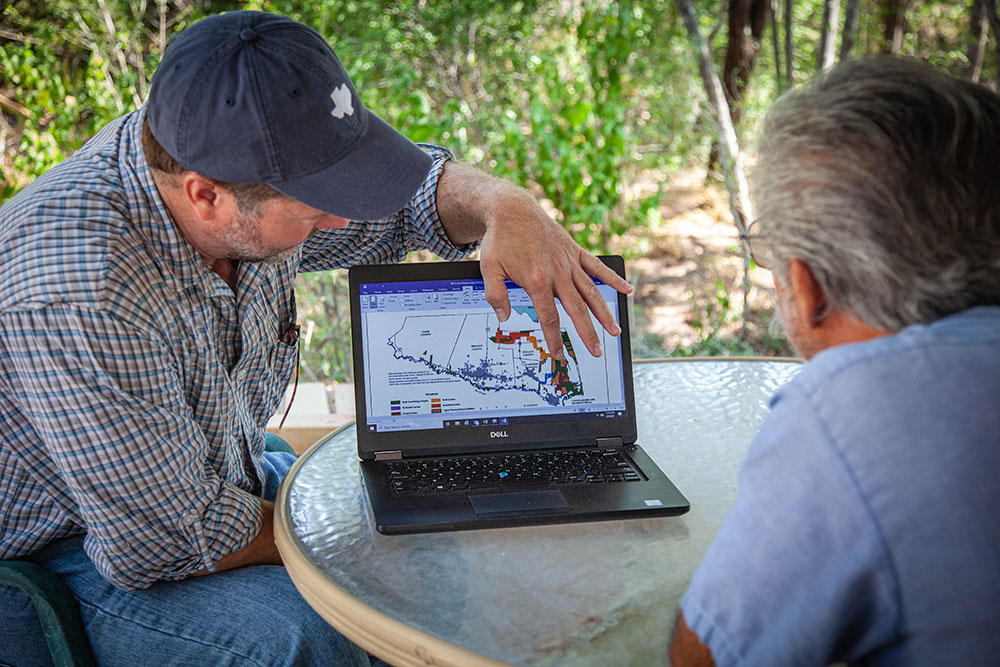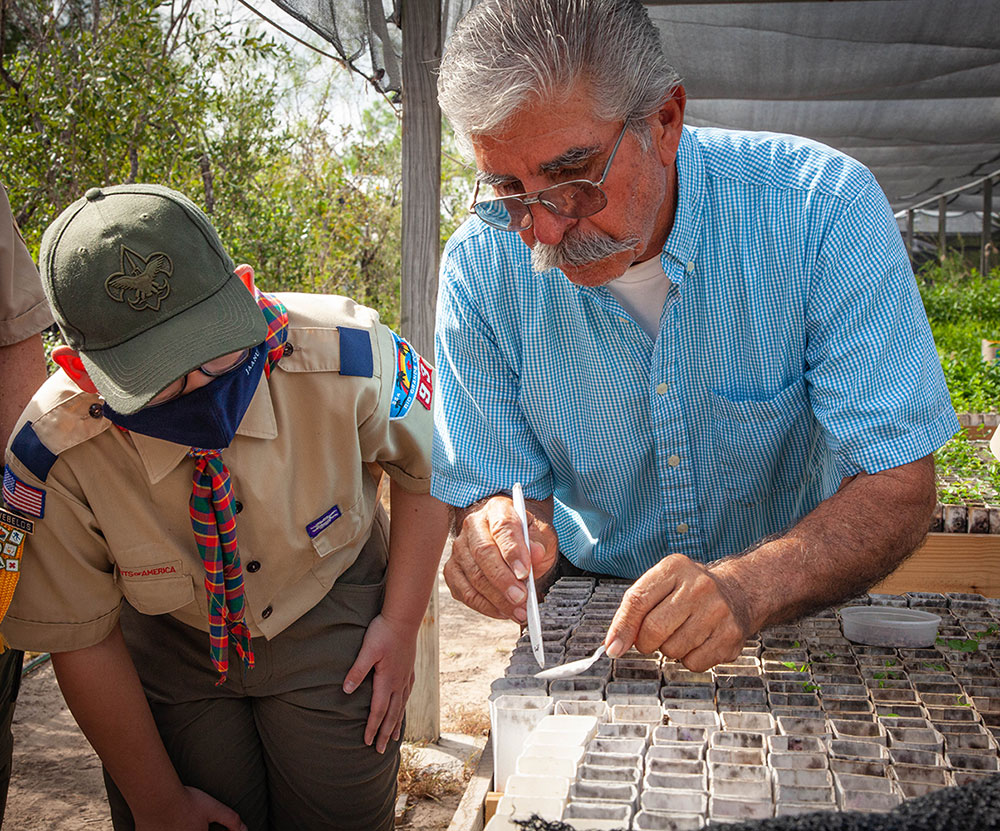
Photo Credit: Jack Gordon & James Foguth / American Forests
BENITO TREVINO IS EXCITEDLY DESCRIBING the wildlife that inhabit his ranch, Rancho Lomitas, deep in the Rio Grande Valley of Texas.
He says he feels “very, very fortunate” to live alongside the indigo snake, a black reptile that can stretch to 8 feet and is notorious for chasing and eating rattlesnakes. By helping control the local rattlesnake population, they serve an important ecological function. And Trevino feels a particular affection for the 3-inch Mexican burrowing toad that spends most of its life underground and emerges after a hard rain for a frantic one-to-three-day mating period.
“They come out of their burrows and start making a ‘Wow! Wow!’ sound that travels about 2 miles,” he says of the toads’ mating calls.
Their continued existence on Rancho Lomitas is an indicator of why Trevino’s land is unique.
Agriculture and urban development are squeezing wildlife into smaller and smaller pockets of land, meaning that species such as these are in trouble across the Rio Grande Valley. The Mexican burrowing toad, for example, is listed as threatened by the Texas Parks and Wildlife Department, but if Trevino has anything to say about it, these and other species will always have a safe haven on his ranch.
Trevino is an ethnobotanist, a native plant nursery owner, a teacher to generations of residents and a local legend. While he loves the reptiles, birds, butterflies and other species that flourish here, his true passion is the plants.
“It’s pretty much been my whole life devotion to our native plants,” Trevino says. “To me it’s not just preserving it for wildlife, but preserving it for human beings, for us, for our children to enjoy.”
Jon Dale leads American Forests’ work in the Rio Grande Valley and Mexico and has known Trevino for a long time. He says that protecting plant diversity is central to building forest corridors for threatened and endangered species such as the northern aplomado falcon, Texas tortoise and ocelot. The Rio Grande Valley is home to America’s only population of ocelot, a jaguar-like cat species that also lives across the border in Mexico.
“Benito’s known as an innovator on seedling production. He was one of the first people to really get involved with it decades ago,” Dale says. “But he’s so much more than that. His deep knowledge, understanding and teaching about the importance of saving natural plant diversity in this threatened ecosystem is priceless.” Trevino’s story began in 1947, when he was born one of 15 children in a migrant farm worker family in Starr County’s Rio Grande City. His early years instilled a powerful sense of place and a deep respect for the native plants and their medicinal properties. He was so close to the border with Mexico that he could throw a rock into the Rio Grande River from his house.
He grew up living with and learning from his grandparents. They would often go weeks without traveling to town, he remembers, because they were poor and most of what they needed was available from the land.
“They would be constantly teaching us how can you survive in this harsh environment,” Trevino says. “Learning how to weave, how to make rope, how to go to the forest and collect edible native plants or medicinal native plants, how to make soap — things that were needed for survival.”
If someone was kicked by a horse during branding season, he learned how to look for manzanita (Barbados cherry) to reduce the swelling. If that same kick caused a headache or body pain, he would be sent out to gather willow bark and prickly pear cactus root to create a buffered aspirin.

Photo Credit: Jack Gordon & James Foguth / American Forests
“It wasn’t until I was in college that I learned that salicylic acid was derived from the willow bark,” he says. “So, they made that concoction — buffered, flavored aspirin — long before aspirin was invented.”
While still in high school, Trevino was involved in the migrant farm workers movement. In 1966, several of his family members marched over 400 miles to the State Capitol in Austin as part of La Huelga, a protest against the injustice and poor treatment endured by migrant farmworkers. Part of the movement’s legacy was President Lyndon Johnson’s creation of National Hispanic Heritage Month.
“La Huelga was a sacrifice that many Hispanics throughout South Texas made to improve our way of life,” Trevino says. “National Hispanic Heritage Month gives us an opportunity to reflect on the contributions that Hispanics have made to our country.”

Trevino was unable to join the march himself because the day it began was also the day he graduated from high school and enlisted in the Air Force with an eye toward using the G.I. Bill to afford college. Stationed at Dyess Air Force Base in Abilene, Texas, he loaded nuclear weapons onto B-52s as part of Operation Chrome Dome, the United States’ strategy to keep nuclear-capable bombers airborne 24/7 to quickly strike back after a Soviet attack.
With a chuckle, he notes that the man who recruited him to work on nuclear weapons said, “we’re selecting you in a career that might be like repairing watches or something that requires a lot of hand skill, and where you have to be very calm!” Additional postings in Colorado, Michigan and Thailand followed before he left the military with enough money to finance the rest of his education.
At the University of Texas, Austin, Trevino turned his passion for plants into a lifelong mission. It was slow going as he also spent months working labor-intensive jobs, and often took night classes. On the advice of the dean, he went into botany even though he wasn’t familiar with the word botanist at the time.
After graduation, he struggled to find work at a decent wage in botany, so he took a job as a laboratory technician at a chemical company, where he met his wife, Toni. In 1986 they bought a 177-acre ranch in the area where he grew up and named it Rancho Lomitas. They began growing and selling native plants before most people recognized their importance, while also renting casitas and leading educational tours about the importance of protecting native plants and animals. They’ve since added to Rancho Lomitas by purchasing the 95-acre ranch next door.
Rancho Lomitas has six soil types, meaning there are multiple mini-landscapes with different species across the ranch. It’s home to at least six threatened native species, 198 species of birds, 16 species of snakes, 148 species of butterflies and at least 550 species of native plants.
Trevino grows plants and works on habitat restoration projects for Texas Parks and Wildlife, The Nature Conservancy and the U.S. Fish and Wildlife Service. He and Dale have discussed the conservation plan American Forests developed with the Thornforest Conservation Partnership, as well as the need to collect and grow more seeds to save this unique but disappearing ecosystem.

Photo Credit: Jack Gordon & James Foguth / American Forests
“It’s such a privilege to be working with them, to know that what I’m doing can be multiplied so many times more with their efforts,” Trevino says. “My goals are pretty much 100% in line with their goals because I love forests — there’s something magical about a forest.”
Rio Grande Valley native Gisel Garza, who leads American Forests’ seed collection, processing and planting efforts in southern Texas, shadowed Trevino at his nursery when she joined the organization in 2021.
“I learned so much from him about seed collecting and growing of our native plants,” she says. “He’s an encyclopedia of knowledge about the biodiversity here and is passionate about conserving thornforests and serving as an environmental educator to our community.”

Photo Credit: Jack Gordon & James Foguth / American Forests
Trevino gets emotional recalling a big restoration project that he was struggling with for weeks, trying to figure out which species he should use and where to convert a blank pastureland into a native habitat. Finally, while sitting at Rancho Lomitas in the early morning, he watched the sun rise, and as the fog began to dissipate he noticed the incredible interplay of light, moisture, land and trees.
“It was just incredible, the different colors of the leaves, the way they would move with the wind and the way the light was shining,” he says. “And I thought, ‘I’m going to mark this area and get my notepad.’ So, I spent three days studying that whole environment to transport it over to my project to create that beautiful scene that nature created for us.”
Trevino recently hit a major milestone with his millionth plant grown from a seed, leaving him reflective about his legacy.
“Hopefully I was able to at least educate people of what we need and how important our native things are here, not just for the animals, but for the humans. We need all these trees and plants and things as much as the reptiles and birds need them. I hope that I was able to at least start a little spark in young minds that will continue doing what I’ve started to do.”
Lee Poston is a communications advisor who works with mission-driven organizations and writes from University Park, Md.